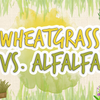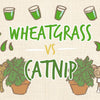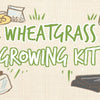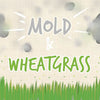Wheatgrass Vs. Alfalfa
When it comes to health trends, microgreens and other sprouts sit at the top of the list. Wheatgrass and alfalfa sprouts are the most widely grown and also contain some of the healthiest natural amounts of nutrients and chlorophyll content. This guide will go into detail on everything there is to know about wheatgrass and alfalfa sprouts, their differences, taste, health benefits, and how to prepare each.
What Is Wheatgrass?
Wheatgrass is defined as the first leaves that have been freshly sprouted from the common wheat plant (Triticum aestivum). Wheatgrass can be used to make wheatgrass juice, dietary supplements, powdera, capsules, or tablets. Wheatgrass contains concentrated amounts of nutrients such as amino acids, iron, magnesium, and calcium, among other nutrients.
What Are Alfalfa Sprouts?
Alfalfa sprouts are 3 to 5-day old alfalfa shoots. When dry, mature alfalfa seeds are activated by being soaked for at least 12 hours, and the germination process will automatically start. The sprouts reach optimal flavor by the time they are 2 inches tall, after which they are harvested.
Differences Between Wheatgrass And Alfalfa
While wheatgrass and alfalfa sprouts are both potent health elixirs, they do have many differences in terms of how long they grow, their taste, nutrient content, and even consumption differences.
|
Alfalfa |
Wheatgrass |
|
|
How Long To Sprout |
3 Days |
6-10 Days |
|
Taste |
Mild, Nutty, Crunchy |
Slightly Sweet |
|
Smell |
Earthy, Tea |
Freshly Cut Grass |
|
How Best Consumed |
Salad or Sandwich |
Juice, Shot, Smoothie |
How Long To Grow - Alfalfa seeds germinate at a much faster rate compared to other legumes and will have sprouted by the third day. The young shoots are usually ready to harvest by the third day if they are kept under optimal conditions in terms of temperature (65-85°F) and watered regularly (after every 8 to 12 hours).
It takes between 6 to 10 days for wheatgrass to grow and reach the harvest size. However, wheatgrass seeds can germinate in as little as 2 days when grown in trays or ports. The average growing time of wheatgrass can be altered by cultural conditions such as insufficient light and water.
Taste - Alfalfa sprouts have a mild nutty flavor and a crunchy texture. The sprouts don't have to be cooked as the flavor is readily available; besides, the tiny yellow to dark green leaves growing on the sprouts are too delicate to cook.
Wheatgrass has a mildly sweet taste that is similar to green tea. However, different wheatgrass products such as fresh wheatgrass juice, wheatgrass shots, and wheatgrass powder have different tastes. Fresh wheatgrass juice exhibits a definite taste with an earthy aftertaste, known and a raw pungent taste. A shot of wheatgrass has a bitter taste; hence it is essential to cover it with some sweet fruits to do the trick. Lastly, wheatgrass powder has a bitter earthly flavor.
Smell - Fresh alfalfa sprouts have a fresh earthy tea-like smell. If your sprouts have developed a sour or pungent smell, it's time to throw them away as they are likely to be rotting or infested with fungi cultures
Wheatgrass produces a fresh 'green' scent that is similar to the smell of newly mown grass. Although the scent of wheatgrass may make some people' instantaneously ill,' wheatgrass lovers find this smell appealing and very tolerable.
Consumption Differences - Alfalfa seeds are rather tiny, making them almost impossible to cook and eat whole. This leaves sprouting as the only decent way to enjoy alfalfa seeds. The seeds contain a compound known as canavanine. This compound inhibits the absorption of normal proteins making existing lupus condition worse. The sprouting process reduces the levels of canavanine, making the alfalfa sprouts a great source of essential nutrients.
Commonly wheatgrass now appears in health food stores, in its raw shoot form as well as juice, shots, powders, and shakes - making it easy to consume on the go. Wheatgrass drinks can be a great alternative to other beverages that you may consume. By switching your can of soda or latte for a wheatgrass shake can be a great way to reduce your weight.
Why Grow Wheatgrass?
- Sprouted Wheatgrass Contain Readily Available Nutrients
Wheatgrass is an excellent source of numerous different minerals and vitamins. It is particularly high in iron, calcium, magnesium, and amino acids, as well as vitamins A, C, and E. These nutrients play crucial roles in the human body, for example, the building and repairing of tissues. The fiber found in wheatgrass is also essential for digestive health and regular bowel movements.
- For Fun
The process of sprouting wheatgrass can be an exciting activity and fun for most individuals because it is an outstanding activity where all members of the family may participate. The fast sprouting of roots and shoots makes both entertaining and educational experience.
- Quicker Cooking
Soaking and sprouting of wheatgrass seeds soften them. This, as a result, makes it possible for the sprouts to cook faster compared to dried wheatgrass seeds, which take longer to cook.
- Can Be Carried Out Indoors
Sprouting wheatgrass seeds does not require complicated and expensive equipment because all that is needed is a sprouting kit or a mason jar. Additionally, other simple requirements such as wheatgrass seeds and water for soaking and rinsing can be easily obtained to facilitate the sprouting process. Wheatgrass seeds will definitely sprout faster indoors compared to outdoors because the temperature is within the required optimum range.
- It Is Economical
Sprouting wheatgrass at home is much more economical than buying sprouted wheatgrass from other dealers. This is because all dealers in wheatgrass sprouts are profit-oriented as compared to home-made wheatgrass sprouts that are primarily intended for domestic consumption. Notably, most equipment used in sprouting wheatgrass can be readily available at home hence saving the cost of purchasing other sprouting equipment.
Why Sprout Alfalfa?
- Increased Nutrition Count
The sprouting process unlocks the stored nutrients in the seed, making them readily available for absorption upon digestion. Alfalfa seeds are rich in vitamins C and K, minerals like copper, manganese, magnesium, and iron.
- It's Economical
Sprouting alfalfa seeds makes them worth more in terms of nutritional value. The sprouting process also involves a drastic increase in size by over 400%. Sprouting a handful of alfalfa seeds will give you up to 8 oz. worth of sprouts, which can be stored in the fridge for later use.
- It's The Only Way To Consume Alfalfa
Alfalfa seeds are rather tiny, making them almost impossible to cook and eat whole. This leaves sprouting as the only decent way to enjoy alfalfa seeds.
The seeds contain a compound known as canavanine. This compound inhibits the absorption of normal proteins making existing lupus condition worse. The sprouting process reduces the levels of canavanine, making the alfalfa sprouts a great source of essential nutrients.
- Can be Done Indoors
Alfalfa sprouting does not require any specialized care; all you need is a flat-sided mason jar or a sprouting kit. The seeds will sprout much faster indoors as the temperature is within the optimum range.
Wheatgrass Nutrition (per 16 oz. serving size)
- Calories:25
- Protein: 1 g
- Fiber: 4 g, or 14% of Daily Value (DV)
- Carbohydrates: 6 g, representing 2% of an adult's DV
- Calcium: 24 milligrams (mg)
- Vitamin K: 86 micrograms, representing 70% of DV
- Iron: 1 mg, representing 6% of DV
Health Benefits Of Wheatgrass
High In Antioxidants And Nutrients - Wheatgrass is known to be an excellent source of minerals and vitamins. These include calcium, magnesium, amino acids, and vitamins A, C, and E. Wheatgrass, just like other greens, contain chlorophyll, which contains numerous essential antioxidants, vitamins E and C, and glutathione which fights free radicals to help reduce oxidative stress and prevent cell damage. Antioxidants may also protect against various conditions like cancer, heart disease, neurodegenerative disease, and arthritis. Reference: link.
Prevention And Treatment Of Cancer - The high antioxidant content in wheatgrass suggests that the consumption of wheatgrass may be useful in killing cancer cells. Research studies have indicated that combining traditional cancer treatment with wheatgrass juice may minimize the adverse effects of cancer by killing cancer cells and reducing the development of cancer in the body. Reference: link.
Treating Gastrointestinal Distress - Traditional medicine practitioners have used wheatgrass for a long time to reduce stomach pain and manage slight gastrointestinal problems like digestive problems and diarrhea. Wheatgrass is rich in fiber, which helps in keeping the gut healthy. Researchers have also established that wheatgrass can be useful for treating ulcerative colitis, a provocative condition affecting the large intestines. Individuals who use wheatgrass for treating gastrointestinal distress usually experience reduced rectal bleeding and less disease activity. Reference: link.
Prevention And Treatment Of Type 2 Diabetes - Wheatgrass raises insulin levels and helps in lowering blood glucose. Since inflammation plays an essential role in diabetes, experts have found that wheatgrass fights inflammation hence assisting people in managing diabetes and other complications associated with the disease. Reference: link.
May Alleviate Inflammation - Wheatgrass has a high content of chlorophyll, a plant pigment that contains strong anti-inflammatory properties. Inflammation refers to a standard response that is generated by the immune system to defend the body against infection and injury. Although chronic inflammation is connected to conditions such as heart disease, cancer, and autoimmune disorders, research has shown that wheatgrass and its components are essential in reducing inflammation. Reference: link.
Health Benefits Of Sprouted Alfalfa
Cholesterol Control - Alfalfa sprouts contain compounds such as saponins, which reduce the level of bad LDL cholesterol. This reduction leads to an increase in good HDL cholesterol. Having healthy cholesterol levels goes a long way in preventing heart disease and other health complications. One study found that eating 40 grams of alfalfa sprouts per day did decrease total cholesterol by 17%. Reference: link.
Improved Metabolism - While research is still on-going, alfalfa sprouts have been shown to lower blood sugar levels and improve metabolic health when consumed. In fact, alfalfa was used to treat diabetes in ancient times. This is achieved by partly increasing insulin production in the pancreas. Reference: link.
Relieving Menopause Symptoms - Alfalfa sprouts contain phytoestrogens that ease menopause symptoms. This is due to the fact that phytoestrogen behaves like estrogen, and its presence in the bloodstream can trigger a reduction in the symptoms associated with the decline of estrogen levels. Consuming alfalfa sprouts can, therefore, reduce some of the symptoms such as hot flashes and night sweats. Reference: link.
Antioxidant Effect - Alfalfa sprouts are rich in antioxidants and bioactive plant compounds. These react with free radicals, which are by-products in the metabolism process. Reacting with free radicals prevents genetic damage to the cells, which usually results in cancer. Alfalfa sprouts have been used for over 300 years in ancient medicines. Ref: link.
Low Calorie - With as little as 8 calories per 1 cup, alfalfa sprouts are suitable for a low-calorie diet. This makes it a perfect source of vitamins and minerals without any additional calorie intake. The low calorie also aids in weight control with the reduction in calorie intake. Ref: link.
Nutritional Value of Alfalfa Sprouts (per 1 cup serving)
Macronutrients
- Protein: 1.3 g
- Calories: 7.6
Micronutrients
- Vitamin A: 5 mg
- Vitamin K: 10.1 mcg
- Vitamin C: 2.7 mg
- Folate: 11 mcg
- Calcium: 10.6 mg
- Iron: 0.3 mg
- Magnesium: 8.9 mg
- Phosphorus: 23 mg
- Potassium: 26 mg
- Sodium: 2 mg
So: Which Is Healthier?
Alfalfa sprouts contain more nutrients per single serving compared to wheatgrass and also does not run the risk of containing gluten.
Wheatgrass, Alfalfa, And Celiac Disease
What Is Celiac Disease?
Celiac disease is a common digestive condition where the small intestine becomes inflamed and unable to absorb nutrients. People living with celiac disease suffer from symptoms such as: bloating, constipation, abdominal pain, to name a few. As celiac disease is an autoimmune disease, it mistakenly causes the body to fight healthy tissue. This is caused by consuming food that contains gluten.
Can You Eat Wheatgrass Or Alfalfa Sprouts When Suffering From Celiac's Disease?
Wheatgrass undergoes a breakdown of stored nutrients during germination, which leads to the elimination of gluten content from the wheatgrass. Alfalfa sprouts are considered as gluten-free, and therefore both microgreens can be consumed when suffering from celiac disease.
HOW TO SPROUT ALFALFA
Equipment Required
- Mason jar or a sprouting container/kit
- Mesh sprouting lid to fit the mason jar
- Large bowl
Ingredients Required
- Sprout-ready alfalfa seeds- 2 tablespoons
- Filtered water
Method for Sprouting
- Rinse the sprout-ready alfalfa seeds and remove any debris or floating matter
- Place the seeds in a large bowl and half fill it with filtered water. Soak the seeds for 8 hours or overnight
- Drain the water and rinse the activated alfalfa seeds
- Place the seeds in a mason jar or a sprouting kit. Cover the jar with a mesh sprouting lid, which keeps out contaminants while also allowing air to flow freely into the jar
- Keep the jar inverted over a large bowl at an angle which will allow any remaining moisture to drain out
- Rinse and drain the sprouts every 8 to 12 hours for 3 days
- When the sprouts start growing, you can transfer them into indirect light, which significantly improves the growth of tiny green leaves. Avoid direct sunlight as it can get too hot and harm the sprouts.
How To Grow Wheatgrass
Our How To Sprout Wheatgrass guide is inspired by Grow Your Pantry’s recommended method.
Equipment Required:
- Mold-resistant coconut coir
- Tray
- Plastic wrap
- Shaded pot
Ingredients Required:
- Water
- Wheatgrass seeds
Method For Growing
Part 1: Sprouting The Seeds
- Buy organic wheatgrass seeds from a reputable retailer in bulk,
- Rinse and drain the wheatgrass seeds before soaking them,
- Soak the wheatgrass seeds in lukewarm, filtered water for 9-12 hours,
- Complete 3 soaking cycles to obtain small, white sprouts.
Part 2: Transfer The Seeds To A Growing Medium
- Grow the wheatgrass seeds in cheap, mold-resistant coconut coir,
- Cover 6.4 centimeters of the deep tray with 2.5 centimeters of growing medium,
- Use kelp fertilizer and water to moisten the growing medium,
- Spread the sprouted wheatgrass seeds over the medium in a thick, even layer,
- Lightly sprinkle the growing medium over the seeds to cover them partially,
- Mist the tray and cover it loosely with a plastic wrap.
Part 3: Caring for The Sprouts
- Place the tray for 1-2 days in a warm, shaded pot,
- Water the tray to moisten the growing medium,
- Once the green shoots emerge, transfer the tray to a brightly lit place,
- Harvest the wheatgrass when they are about 15-18 centimeters tall,
- Wash and eat your harvested wheatgrass sprouts.
Conclusion
While wheatgrass is cheaper and much easier to grow, it takes much longer. On the other hand, alfalfa sprouts take as little as 3 days to grow, but they require quite a more detailed sprouting process.
How To Consume Wheatgrass
Wheatgrass Juice - Wheatgrass juice is an excellent source of several different minerals and vitamins that are required by the body to function well. It also helps to increase the levels of different antioxidants such as vitamin C and glutathione.
Wheatgrass Shots - Wheatgrass shots are known to help in protecting the body against toxins, colds, and harmful molecules. They are considered to be the center for health and contain 70% chlorophyll that helps to reduce the risks of cancer and fight carcinogens in the human body.
Wheatgrass Powder - There are many ways of eating raw wheatgrass, such as wheatgrass powder. This can be made through dehydration or freeze-drying, and the powder can be added to smoothies and fresh juice, or blended in water.
How To Consume Alfalfa Sprouts
While there are many ways you can add alfalfa sprouts to your diet, consuming it in its raw form produces the maximum nutritional content. Freshly harvested or frozen alfalfa sprouts can be added to a sandwich or mixed into a salad without any processing needed.
Where To Buy From
Alfalfa Sprouts
Due to their short shelf-life, alfalfa sprouts are not a standard product in most stores. Instead, they opt to stock up on alfalfa sprout-ready seeds, which have a much longer shelf life.
Local Farmers Market - Fresh alfalfa sprouts can be found in most farmer's markets; these are mainly from small scale growers. Ensure that you check the freshness of the sprouts; generally, the stems should remain firm if the sprouts are fresh.
Grocery Stores - Local grocery stores are more likely to stock up on fresh alfalfa sprouts. Some of the chain stores that often stock up on alfalfa sprouts include Jimbo's, Tony's, Ultra Foods, and Village market.
Wheatgrass
Wheatgrass sprouts are readily available in farmers' markets, vegan stores, and also in local grocery stores. Additionally, you can order wheatgrass online from Amazon from various parts of the world.
Risk Associated With Consuming Alfalfa Sprouts And Wheatgrass
Although wheatgrass is usually considered to be safe, in its raw form, it may contain bacteria and molds that may cause infections and food poisoning.
Who Is At Risk?
- Pregnant women
- Children below 2 years
- Allergic individuals (especially those allergic to grass or wheat)
Making It Safe For At-Risk Groups
Wheatgrass can be made safe for at-risk groups through boiling or steaming. Exposing wheatgrass sprouts to high temperatures is essential in disabling or killing the dangerous bacteria, which may contaminate the sprouts. Bacterial development in wheatgrass sprouts makes them unsafe for eating.
Equipment
- Wooden steam bucket
- Large pot
Method
- Boil a half-way filled water pot using medium heat.
- To steam the wheatgrass sprouts:
- Put your wooden steam bucket in the boiling pot.
- Add the wheatgrass sprouts and cover.
- Steam the wheatgrass sprouts for 25-30 minutes.
- For boiling the wheatgrass sprouts:
- Place the wheatgrass sprouts in the boiling water pot and leave for 15-20 minutes.
Risk Associated With Consuming Alfalfa Sprouts
Alfalfa sprouts are considered to be a high-risk food just like other raw sprouts due to the high likelihood of contamination with harmful culture during the germination process. The wet conditions frequently involved in rinsing the sprouts can provide the right conditions for such cultures to grow.
Alfalfa Sprouts And Wheatgrass Juice Powder
When microgreens are pressed they release a green juice that's rich in chlorophyll and other nutrients when dried and processed the powder can be used as a microgreens powder. Storing wheatgrass and alfalfa sprouts in dried powder form ensures that they have a much longer shelf life.
Can You Drink Both In The Same Day?
While it's possible to drink both microgreen juices on the same day, it's recommendable to start off with small serving amounts, preferably below 10 g per day, and scale up as need over time as your digestion becomes used to the juice.
Interested In Growing Wheatgrass? Check Out Our Recommended Products







